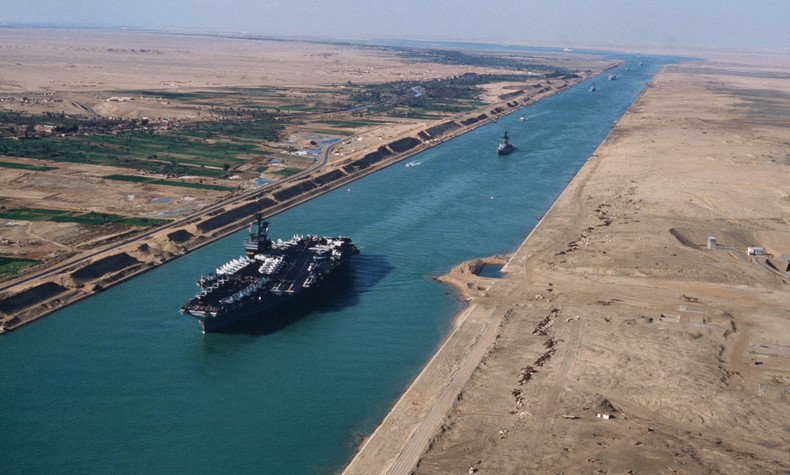The Suez Canal, also known as Qanāt as-Suwais in Arabic, is an artificial sea-level waterway in Egypt. It connects the Mediterranean Sea to the Red Sea through the Isthmus of Suez, effectively separating Africa and Asia and the Sinai Peninsula from the rest of Egypt. The 193.30-kilometer-long (120.11 mi) canal is a crucial trade route between Europe and Asia.
In 1858, French diplomat Ferdinand de Lesseps established the Compagnie de Suez specifically to build the canal. Construction took place from 1859 to 1869, and the canal officially opened on 17 November 1869. It provides vessels with a direct route between the North Atlantic and northern Indian oceans via the Mediterranean Sea and the Red Sea, saving approximately 8,900 kilometres (5,500 mi) and reducing the journey time to London by 10 days at 20 knots (37 km/h; 23 mph) or 8 days at 24 knots (44 km/h; 28 mph).
The canal stretches from Port Said in the north to Port Tewfik in the south at the city of Suez. In 2021, more than 20,600 vessels passed through the canal, averaging 56 per day.
Initially, the canal had a single-lane waterway with passing locations in the Ballah Bypass and the Great Bitter Lake and no locks, as per Alois Negrelli's plans. The water in the canal north of the Bitter Lakes flows north in winter and south in summer, while south of the lakes, the current changes with the tide at Suez.
The canal was owned by the Egyptian government, but European shareholders, mainly British and French, operated it until July 1956, when President Gamal Abdel Nasser nationalized it, leading to the Suez Crisis. Today, the canal is managed by the state-owned Suez Canal Authority of Egypt and is open to vessels of commerce or war regardless of flag, as per the Convention of Constantinople.
The canal has been strategically significant for navies with coastlines and bases on both the Mediterranean Sea and the Red Sea. After Egypt closed the canal at the start of the Six-Day War on 5 June 1967, it remained closed for eight years, reopening on 5 June 1975.
In 2014, the Egyptian government began an expansion project to widen and speed up the Ballah Bypass, aiming to nearly double the canal's capacity. The project, costing LE 59.4 billion (US$9 billion), was funded through interest-bearing investment certificates issued exclusively to Egyptian entities and individuals.
The Suez Canal Authority officially opened the new side channel in 2016, which serves the East Terminal for berthing and unberthing vessels from the terminal. Before this construction, it was not possible to berth or unberth vessels at the terminal while a convoy was running due to its location on the Canal itself.
Prototypes
Ancient canals were constructed to connect the Nile to the Red Sea, facilitating travel from west to east. It is believed that a smaller canal was built under the rule of Senusret II or Ramesses II. Another, larger canal, possibly incorporating a portion of the first, was constructed during the reign of Necho II (610–595 BCE). However, the only fully functional canal was engineered and completed by Darius I (522–486 BCE).
Canals dug by Necho, Darius I and Ptolemy
The remains of an ancient canal that ran from west to east through the Egyptian cities of Bubastis, Pi-Ramesses, and Pithom were discovered by Napoleon Bonaparte and his team in 1799.
According to the writings of the ancient Greek historian Herodotus, around 600 BC, Pharaoh Necho II attempted to construct a canal from Bubastis to the Red Sea, but the project was never completed.
Herodotus mentioned that 120,000 men died during the construction, but this number is likely exaggerated. Necho's successor, Darius I of Persia, completed the project by clearing a natural water passage that had become blocked with silt.
The canal was wide enough for two triremes to pass each other and required four days to traverse. It was later reopened by Ptolemy II Philadelphus and further improved with a navigable lock and sluices to prevent the mingling of salt water from the Red Sea with the fresh water in the canal. Additionally, French cartographers in the 19th century discovered the remnants of a second ancient canal made by Darius I.
